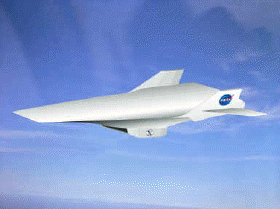
| Home | Bottom |
| SPACE | TRANSPORT: | Spacecraft Tech : | X-43 Hyper X |
Last Updated: January 13, 2002
Hyper-X is NASA's multi-year hypersonic flight research program that seeks to overcome one of the greatest aeronautical research challenges - air-breathing hypersonic flight. Ultimately, the revolutionary technologies exposed by the Hyper-X Program promise to increase payload capacities and reduce costs for future air and space vehicles.
 |
Stats | |
|---|---|---|
| Length : | 3.7 m | |
| Height : | 0.6 m | |
| Width : | 1.5 m | |
| Max. Speed : | Mach 10 | |
| Propulsion : | 1 scramjet | |
The world's fastest air-breathing aircraft ever is the SR-71. It cruises at Mach 3.3. Another US aeroplane, the XB-70, flew at Mach 3.08. USSR's MiG-25 Foxbat are capable of Mach 3.2. NASA's X-15 rocket plane that flew in the late 1950s to the late 1960s, reached a top speed of Mach 6.7. Its pilots have the designation of being the fastest men on planet earth. Hyper-X aircraft are built to fly faster than any previous air-breathing aircraft.
Unlike a rocket that must carry its own oxygen for combustion, an air-breathing engine scoops oxygen from the atmosphere. Without the need to carry oxygen, an air-breathing engine powered vehicle can carry more payload than a rocket-powered propulsion vehicle.
[The Vehicle] [Flight Testing] [X-43 Vs X-30/NASP] [What Next?]
Microcraft Inc has been contracted to construct the X-43A while Oribital Sciences Corp(OSC) will contruct the Hyper-X vehicle i.e. the X-43 + Pegasus XL. The entire program is six years long, costing $185 million.
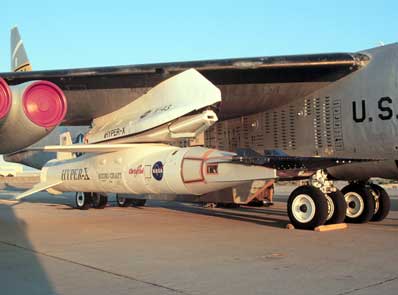
Hyper-X uses only the first stage of Orbital's Pegasus. For a typical space launch, the Pegasus features three stages. The Pegasus stage has some alterations just for X-43 launches, but it is basically the same booster used to deliver small satellite payloads into Earth orbit.
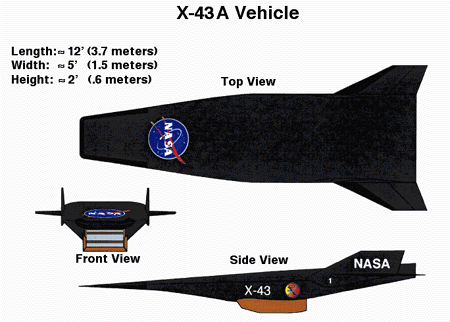
The Pegasus is fitted with a specially-designed adapter structure where the X-43 was attached for the launch. A model of the combined stack has undergone extensive wind tunnel testing along with computer modeling. However, only limited ground testing can be performed on such a vehicle since it is impossible to generate high wind speeds in a wind tunnel.
See Hypersonic Flight and Scramjets to know about X-43's propulsion and hypersonic design.
Hyper-X will ride on the first stage of a Pegasus booster rocket, which will be launched by Dryden's B-52 at 17,000 and 43,000 feet for each mission respectively. For each flight, the booster will accelerate the Hyper-X research vehicle to the test conditions (Mach 7 or 10) at approximately 100,000 feet, where it will separate from the booster and fly under its own power. Vehicle and engine ground tests and analyses will be performed prior to each flight in order to compare flight and ground test results.
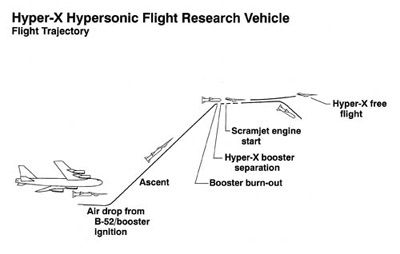
A total of three flights were planned -- two at Mach 7 and one at Mach 10. These will be conducted within the Western Test Range off the coast of southern California and the wholetrack will be over sea.
The first test flight took place on June 2, 2001. The flight test failed. "Some parts came off, but we can't tell what those pieces were," said a spokesman for the NASA Dryden field center soon after the incident. Initial observation was that these parts were of the booster, and not of X-43. The mission control had to auto-destruct the vehicle. "It is clear that shortly after (ignition) that something caused the stack to veer off course," said Kevin Petersen, director of NASA's Dryden Flight Research Center where the B-52 took off for the ill-fated launch.
Of the 30 previous Pegasus flights, three have failed completely including an explosion in the inaugural launch of the XL-version rocket that was blamed on poor modeling of the rocket's aerodynamic design. Two other launches were deemed partial failures because lower-than-planned orbits were achieved.
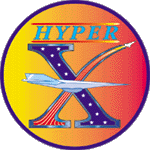
NASP (X-30) is NASA's earlier hypersonic program. You probably have seen its animation umpteen times on TV. One major difference between the Hyper-X program and the previous National Aerospace Plane (NASP) program is the technical approach taken. The NASP program sought to integrate many new, untried technologies into a full-scale test vehicle. The primary legacy of the NASP program was the realization that its multiple technologies, including large scale scramjets, were not mature enough to be flight tested in a single, highly integrated vehicle-system approach. Scramjets required separate flight testing and integration into an airframe, a crucial element in hypersonic vehicle construction.
The Hyper-X program is taking the step-by-step incremental approach, starting naturally enough with the key scramjet engine technology. Also, rather than attempting to construct a large vehicle, Hyper-X will utilize the three small-scale vehicles which save millions of dollars and reduce the possibility of one enormous financial loss in the event of a crash during the flight test program.
"This is a high risk, but a high payoff mission," said Jeremiah Creedon, director of NASA's Langley Research Center. The second flight was slated for Q4 of 2001 and the final X-43A flight to Mach 10 is set for late 2002. However, these are now expected to be delayed.
Let's be clear about one thing : No other country/agency is in a position to construct and flight test their own scramjets except USA/NASA, atleast in the immediate future. Even countries like India have hypersonic concepts, but they are far behind in 'technical expertise'. Australia's HyShot program promises to develop Scramjets at an amazingly low cost - a test was conducted which too failed. It is unclear how complex the HyShot is. What is clear however, that only the success of X-43 will allow further development of full fledged vehicles (that can actually do some useful work too) in the next couple of decades.
Also See :
| Spacecraft Tech | : | Hypersonic Flight and Scramjets |
| Spacecraft | : | HyperSoar |
| Spacecraft | : | AVATAR |
| Spacecraft | : | Tu-2000 |
| Spacecraft | : | MiG-2000 |

Mail ST at [email protected] . Your suggestions are welcome.
| [ Home ] | [ Aircraft ] | [ Explore Space ] | [ Space Stations] | [ Spacecraft Tech ] | [ Spacecraft ] | [ X-Prize ] |
| © Space Transport | Top |